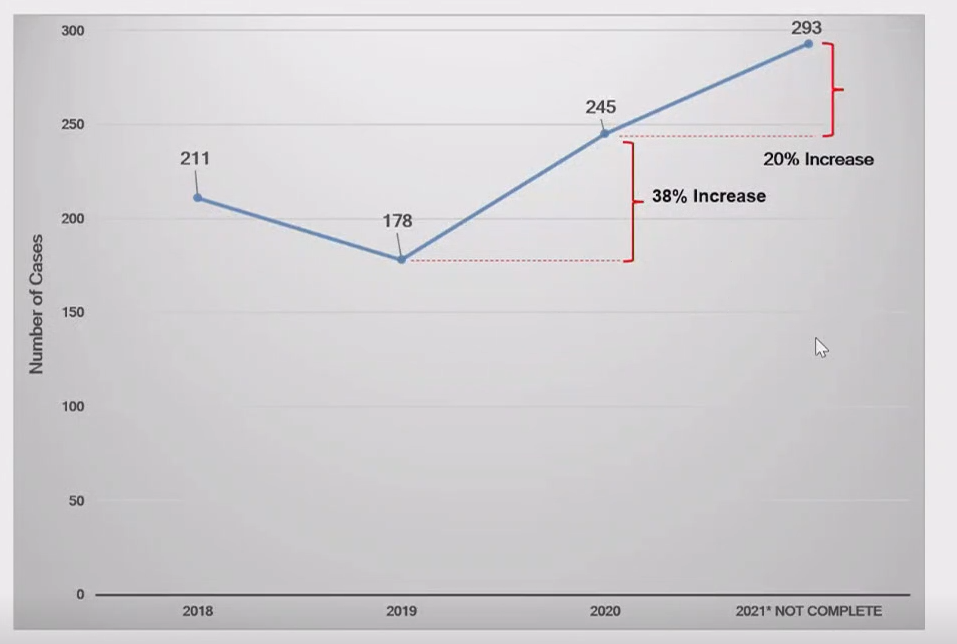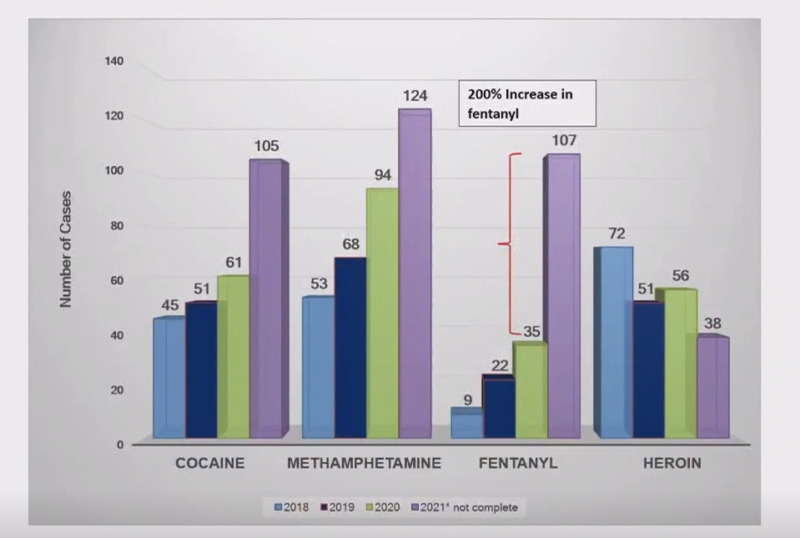Accidental drug deaths in Travis County increased by 20% in 2021, driven by a 200% spike in fentanyl-related deaths, while cocaine and methamphetamine deaths also soared, according to the Travis County Medical Examiner.
“Fentanyl is still by far the greatest threat. What we’re hearing from folks out on the streets is that everything (i.e., every substance) is testing positive for fentanyl right now,” said Heidi Abraham, ATCEMS Deputy Medical Director. “From a medical standpoint, the problem with fentanyl, how it’s causing these deaths, is that it makes patients stop breathing.”
Dr. Keith Pinckard, Chief Medical Examiner, said that his office had tallied 293 accidental drug deaths in Travis County in 2021, and was still working on some cases from December.
That compares to 245 deaths in 2020 and 178 deaths in 2019, for a two-year rate of change of 65%. The majority of deaths, about 60%, involve a deadly cocktail of more than one drug, while 40% showed single-drug toxicity.
Cocaine and methamphetamines remain a significant part of the ecosystem, with cocaine-related deaths doubling from 2019 and methamphetamine increasing 32%.
These figures indicate that the drug was detected in the victim, but not necessarily that it was the principal or only cause of death. Pinckard noted that cocaine, methamphetamine, and fentanyl can all be lethal on their own. Used in combination with each other or with other drugs, they become even more dangerous.
He also noted that until recently, lethal opioid overdoses had been less common in Austin compared to other parts of the country. “Historically, over the past few years, most of our deaths have actually been the stimulants such as cocaine or methamphetamine. That is now starting to change.”
Out of the 293 confirmed drug deaths in Travis County in 2021, 107 involved fentanyl, up from 35 last year, a change of 206%. Just four years ago, in 2018, there were only nine cases in which fentanyl was detected.
Some overdose victims also had taken alprazolam (33), synthetic cannabanoids (10), or oxycodone (6).

Abraham, who responds to overdose calls and supervises other medics who do so, noted that the use of the overdose-countering drug Narcan has surged, but sometimes it was not effective in preventing death. That can be because the patient needs an extra-large dose of Narcan, or because they have other drugs in their system that the Narcan isn’t addressing.
“We have about 30 opioid overdoses per day that we’re seeing in the field here in Travis County. About 20 of those per month are receiving Narcan before EMS arrives. So friends or family members are administering Narcan to these patients, and there’s probably even more than that that we don’t know about just because EMS is never called in those circumstances,” she said.
The Austin Police Department also is giving Narcan three to four times a month. Abraham advised friends and family of users not to count on the Narcan alone if a user overdoses, but to call 9-1-1.
Soaring drug deaths in Travis County come after a years-long push by local officials to handle substance abuse as a public health issue rather than a criminal justice issue. They have allocated for more resources toward public health responses, including distribution of Narcan, while limiting the traditional criminal justice approaches of cracking down on drug trafficking and dealing.
Travis County District Attorney Jose Garza has largely stopped prosecuting drug trafficking. In November he released a plan for combating overdose deaths, which says in part, “Overdose related deaths in our community are preventable through proven public health approaches.”
“The increased availability of lifesaving medications like naloxone and trainings on overdose-avoidance strategies can save lives in our county… criminalization and incarceration only serves to increase the risk of overdose among people struggling with substance use disorder.”
